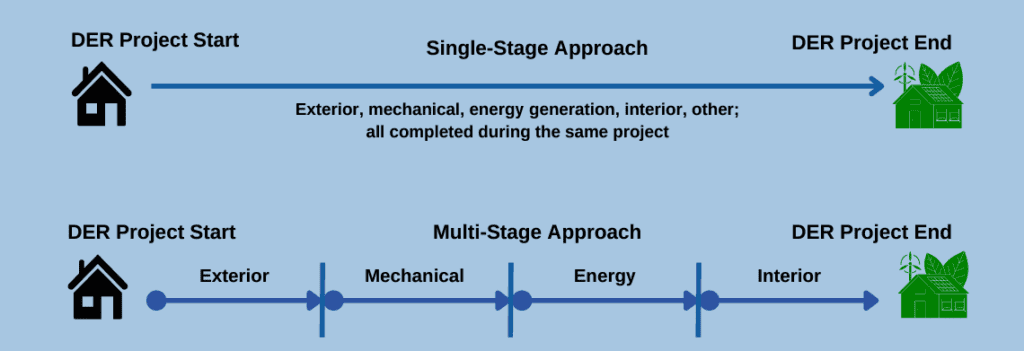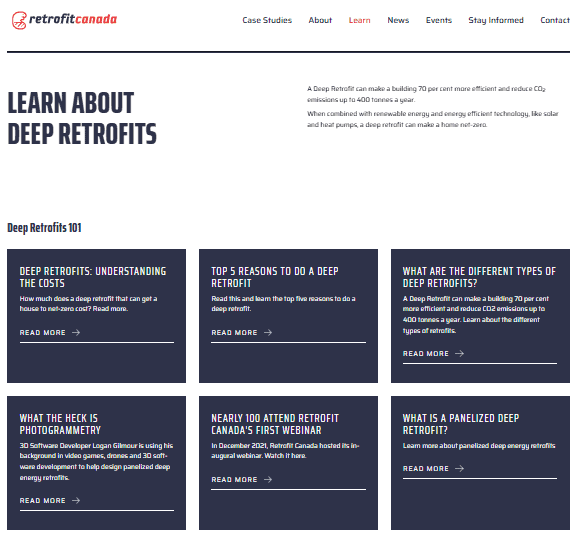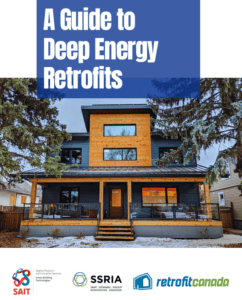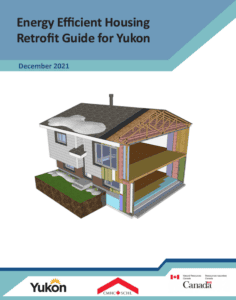Deep Energy Retrofit Guides
Although there is a growing wealth of content on the web that addresses home deep energy retrofits, there is relatively few places where you can find a wealth of information including free guides and online webinars and courses.
Here are a few Canadian sources.
Retrofit Canada
A not-for-profit organization with a mission is to share solutions, eliminate barriers, and accelerate deep retrofits in Canada to avert a climate catastrophe. Find resources in their Deep Retrofits 101 series.
A Guide to Deep Energy Retrofits
SAIT’s A Guide to Deep Energy Retrofits is primarily for building professionals whose work provides opportunities for energy efficiency upgrades and effective Deep Energy Retrofits:
- General Contractors
- Designers
- Project Managers
- Energy Consultants (Advisors)
- Architects
- Tradespeople
The guide is also useful to homeowners and building owners, educators, and advocates. It is intended to provide information associated with deep energy retrofits and to help users identify a pathway for retrofitting to net-zero emission performance for existing single-family homes.
Although focused on single-family homes, the principles described therein are applicable to other building types.
Additional information on Panelized retrofits can be found in Canmet ENERGY’s Prefabricated Exterior Exterior Energy Retrofit (PEER) Project Guide
Energy Efficient Housing Retrofit Guide for Yukon
The Energy Efficient Housing Retrofit Guide for Yukon covers several possible retrofit programs for typical single-family homes in Whitehorse, YT. Retrofits can involve relatively small amounts of work and cost (e.g., minor air sealing work) or more costly and complex work (e.g., below-grade retrofits).
The guide is intended to be used by homeowners and builders as a reference for achieving higher levels of energy efficiency and maximizing utility cost savings and passive survivability through lower energy use.
Negawatts are not just low-hanging fruit;
Amory Lovins
they are lying on the ground.

Deep Energy Retrofit Free Online Courses
A 5 part online series on deep energy retrofits (free) courtesy of SAIT Polytechnic and SSRIA.
In November 2023, SAIT’s Green Building Technologies Access Centre hosted multiple DER Discovery Sessions on the SAIT campus in Calgary, followed by multiple pilot deliveries of the DER course material (both in-person and via webinar), all of which were attended by interested construction industry professionals, SAIT faculty/instructors, SAIT students, and building owners/homeowners.
SSRIA funded the development of educational materials on residential deep energy retrofits (DER) by producing introductory DER course material delivered via five (5) modules linked below, and lastly by constructing physical DER wall example mock-ups for inclusion in SAIT’s existing wall library.
SAIT – DER Module 1 – Intro to Deep Energy Retrofits (45 min)
SAIT – DER Module 2 – Building Science (1 hour 31 min)
SAIT – DER Module 3 – Roadmap (1 hour 28 min)
SAIT – DER Module 4 – Energy Literacy (43 min)
SAIT – DER Module 5 – Case Studies (1 hour 35 min)
For more information consider exploring SAIT’s Deep Energy Retrofit Guidebook.
Retrofit Canada
A series of free deep energy retrofit webinars.

Start your deep energy retrofit today.
Save energy. Make your home more comfortable.
Have less maintenance. Keep more money in your pocket.
Glossary
Annual Energy Use: the total energy required to operate a home for an entire year. The metric is typically expressed in GJ / year or kWh / year, and includes energy used for all mechanical systems (i.e., HVAC, water heating), appliances, and lighting.
Annual Heating Demand: The total energy used to heat a home for an entire year. It is most often expressed in kWh / m² / year.
Building Envelope: The division between the conditioned and unconditioned space of a home or building. Constructability: Ease of construction.
Digital Capture: Produce accurate measurements of the existing building using a digital device and software (Camera, Drone, Lasers, Sensors, Computers, etc.).
Electrification: The process of replacing technologies that use fossil fuels (coal, oil, and natural gas) with technologies that use electricity as a source of energy.
Embodied Carbon: Accounts for the total emissions used to source, manufacture and transport materials used to construct a building as well as the construction methods employed to erect the structure and the end-of-life demolition.
Energy Audit: Testing and analysis of a building’s energy efficiency. Most commonly determined using a blower door test and energy modelling analysis.
Energy Efficiency: The rate at which energy is converted and captured from one form and / or use to another. Energy Use Intensity / Rated Energy Intensity This metric takes the annual energy use and applies it to the total area of a home. It is expressed as GJ / m² / year or kWh / m² / year, and this shows efficiency over floor area of the home but tends to favor larger homes. Geothermal: Relating to or produced by the internal heat of the earth.
High-Performance Home: Home that goes above and beyond minimum building standards, specifically in the areas of energy use, air quality and thermal comfort. Integrated Project Team To be brought together. In terms of construction, bringing everyone involved in the project together.
Mitigation: Action of reducing the severity, seriousness, or painfulness of something. Mechanical Load: Amount of stress a home’s entire mechanical system causes to the grid or on-site energyproducing devices.
Net-zero: In terms of national carbon emissions, targeting net-zero means negating an equal amount of greenhouse gases to the amount produced by human activity. This is achieved by first reducing reliance on emissive activities to minimize new emissions and then implementing methods of absorbing carbon dioxide from the atmosphere.
Net-zero ready: “A home that is recognized by CHBA and NRCan’s EnerGuide Rating System to be a home that has a renewable energy system designed for it that will allow it to achieve Net Zero Home performance, but the renewable energy system is not yet installed.”- CHBA.
Operational Emissions: Refers to all the energy used in managing and maintaining the function of a building. It can include heating, cooling, lighting, and any other power usage needed to run programs.
Panelized: A method of construction consisting of capturing the precise dimensions of a building to pre-fabricate airtight and well-insulated panels. As a result, these panels are delivered to the project site, then are later installed on the exterior of the building.
Peak Load: The maximum of electrical power demand. In Canada it usually occurs in the winter when everyone is running their heaters, but can also occur in the summer when using air conditioners.
Perm Rating: A standard measure of the water vapor permeability of a material. The higher the number, the more readily water vapor (in the gaseous state) can diffuse through the material.
Reference House: A comparative energy model of the same house built to the minimum requirements of the National Building Code, this represents a “typical home” and allows for comparison.
Retrofit: An act of adding a component or accessory to something that did not have it when manufactured. Tenant: A person who occupies land or property rented from a landlord.
Thermal Bridge: An area or component of an object which has higher thermal conductivity than the surrounding materials, creating a path of least resistance for heat transfer.
Abbreviations
ACH: Air Changes per Hour
CHBA: Canadian Home Builders’ Association
DER: Deep Energy Retrofit EA: Energy Advisor
EIFS: Exterior Insulation and Finish Systems
EPS: Expanded Polystyrene Insulation
ERS: Energuide Rating System
ERV: Energy Recovery Ventilators (transfers heat and humidity)
GJ: Gigajoules
HRV: Heat Recovery Ventilator (transfers heat)
HVAC: Heating, Ventilation, and Air Conditioning
IPD: Integrated Project Delivery. Not to be mistaken with the construction term of IPD, which means Insulation / Poly / Drywall.
kWh: Kilowatt hours Thermal Resistance: A heat property and a measurement of a temperature difference by which an object or material resists a heat flow. It is often expressed as the R-Value. It is the reciprocal of thermal conductance which is usually expressed as a U-Value. Traditional Renovation: A renovation (or retrofit) that does not incorporate improved energy efficiency / net zero practices
Utility Capacity: The maximum output an electricity generator can physically produce, whether it is the grid or on-site energy producing devices.



